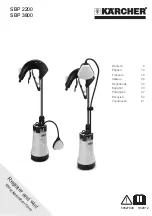
PMKA 20-Li A1
■
4
│
GB
│
IE
2. Electrical safety
a)
Power tool plugs must match the outlet. Never
modify the plug in any way. Do not use any
adapter plugs with earthed (grounded) power
tools.
Unmodified plugs and matching outlets
will reduce risk of electric shock.
b)
Avoid body contact with earthed or grounded
surfaces, such as pipes, radiators, ranges and
refrigerators.
There is an increased risk of electric
shock if your body is earthed or grounded.
c)
Do not expose power tools to rain or wet
conditions.
Water entering a power tool will
increase the risk of electric shock.
d)
Do not abuse the cord. Never use the cord
for carrying, pulling or unplugging the power
tool. Keep cord away from heat, oil, sharp
edges or moving parts.
Damaged or entangled
cords increase the risk of electric shock.
e)
When working outdoors with an electrical
power tool always use extension cords that
are also suitable for use outdoors.
Use of a
cord suitable for outdoor use reduces the risk
of electric shock.
f)
If operating a power tool in a damp location
is unavoidable, use a residual current device
(RCD) protected supply.
Use of an RCD re-
duces the risk of electric shock.
3. Personal safety
a)
Stay alert, watch what you are doing and use
common sense when operating a power tool.
Do not use a power tool while you are tired
or under the influence of drugs, alcohol or
medication.
A moment of inattention while
operating power tools may result in serious
personal injury.
b)
Use personal protective equipment. Always
wear eye protection.
Protective equipment such
as a dust mask, non-skid safety shoes, hard hat
or hearing protection used for appropriate
conditions will reduce personal injuries.
c)
Prevent unintentional starting. Ensure the
switch is in the off-position before connecting
to power source and/or battery pack, picking
up or carrying the tool.
Carrying power tools
with your finger on the switch or energising
power tools that have the switch on invites
accidents.
d)
Remove any adjusting key or wrench before
turning the power tool on.
A wrench or a key
left attached to a rotating part of the power tool
may result in personal injury.
e)
Do not overreach. Keep proper footing and
balance at all times.
This enables better control
of the power tool in unexpected situations.
f)
Dress properly. Do not wear loose clothing or
jewellery. Keep your hair and clothing away
from moving parts.
Loose clothes, jewellery or
long hair can be caught in moving parts.
g)
If devices are provided for the connection of
dust extraction and collection facilities, ensure
these are connected and properly used.
Use
of dust collection can reduce dust-related
hazards.
h)
Do not allow yourself to get lulled into a false
sense of security and do not ignore the safety
rules for power tools, even if you are familiar
with the power tool after repeated use.
A careless action can cause severe injury within
a fraction of a second.
4. Power tool use and care
a)
Do not force the power tool. Use the correct
power tool for your application.
The correct
power tool will do the job better and safer at
the rate for which it was designed.
b)
Do not use the power tool if the switch does
not turn it on and off.
Any power tool that
cannot be controlled with the switch is
dangerous and must be repaired.
Summary of Contents for 359201 2110
Page 3: ...A C D B...
Page 18: ...PMKA 20 Li A1 14 GB IE...
Page 62: ...PMKA 20 Li A1 58 NL BE...
Page 102: ...PMKA 20 Li A1 98 SK...
Page 116: ...PMKA 20 Li A1 112 ES...
Page 142: ...PMKA 20 Li A1 138 IT...









































